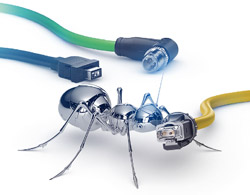
Posted to News on 30th Oct 2017, 09:32
Miniaturisation of connectors as an IoT enabler
Andreas Huhmann, a strategy consultant for connectivity and networks at Harting Technology Group, explains why the miniaturisation of connectors is an enabling technology for the Internet of Things (IoT).

The Internet of Things is growing and is encompassing new small participants. This also applies to industry, and is ultimately a key theme of Integrated Industry. Unified Ethernet is being expanded for this - but only in a seamlessly integrated ecosystem.
Even though the Ethernet is a scalable and flexible protocol, this is nevertheless not true to the same extent for the connectors that are employed. At the beginning, the industrial sector was in agreement: the RJ45, the symbol of Ethernet, needed to be used. Compatibility prevailed over all other considerations - even much more so than rationality. Since the RJ45 had only limited suitability for industrial uses at the time, the birth of the Harting RJ Industrial proved to be the world's first industrial-grade RJ45 connector.
But there was something that distinguished the RJ45 even back then: the large system made up of active and passive components for network infrastructure and its proliferation among IT devices. It chose the most universal ecosystem. This subsequently found its way into industrial automation; nevertheless, today it is bumping up against miniaturisation limits. Ethernet participants are getting smaller, and the network is extending all the way to sensors and the smallest actuator. And since there is no alternative to Ethernet, the established ecosystem is no longer sufficient.
Miniaturisation within existing infrastructure
Devices inside the switch cabinet use Ethernet to communicate with each other. Many of these devices are constructed as small cyber-physical systems. These devices require a high-performance and miniaturised network connection. This, once again, requires the integration and use of existing infrastructure. The arrival of the new ix Industrial connector means a worthy little brother of the RJ45 is now available.
As miniaturisation has progressed, sensors have become too small for the established connectors in the IP67 area. However, the existing transmission physics and integration into the existing active and passive infrastructure are needed. The promising candidate for this mating face is the M8 d-coded connector. It can be employed with the existing physical layer and, therefore, with infrastructure and devices.
If it had been technically feasible during the introduction of Ethernet in industrial automation, industrial users would have demanded a one-pair solution for Ethernet comparable to the fieldbus. The T1 Ethernet means that one-pair Ethernet is now available. Industrie 4.0 is bringing about disruptive changes that give opportunities to a new physical l layer. Ethernet is simply deployed everywhere, even over long ranges and with high performance, while using the simplest and most economical installation. The demands for miniaturisation are now added to this. With T1, the technology for this is available. But if the compatibility with today's physical layer is abandoned, a new ecosystem will emerge, whose distinctive feature will be the definition of a new mating face. Harting has developed this new mating face in the context of international standardisation.
Go to www.harting.co.uk for more information about miniature connectors.
Want the latest machine building news straight to your inbox? Become a MachineBuilding member for free today >>

















